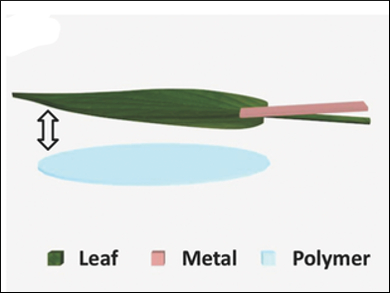Triboelectric nanogenerators (TENGs) can be used to harvest energy from mechanical movement. Leaves moving in the wind, for example, could theoretically provide energy.
Ning Wang, Xia Cao, University of Science and Technology, Beijing, China, Zhong Lin Wang, National Center for Nanoscience and Technology (NCNST), Beijing, China, and Georgia Institute of Technology, Atlanta, USA, and colleagues have developed a triboelectric nanogenerator which uses a natural green leaf as an electrification layer to effectively harvest mechanical energy.
The team used leaves from Hosta plantaginea, which were attached to a poly(methyl methacrylate) (PMMA) layer. Metal clips were connected to the leaves as electrodes (assembly pictured). The leaves contain a natural electrolyte solution, which can be used as a conductive liquid in the device. Under an external mechanical force, contact electrification occurs at the interface between the leaf and the PMMA layer due to their different electron affinities. This causes a polarized electrical double layer at the metal/electrolyte interface, which can drive an electron flow in the external circuit and, thus, convert movement into electricity.
The developed TENGs have a maximum output power of about 45 mW m−2, which is enough to drive, e.g., LEDs or electronic temperature sensors. The researchers also built a tree-shaped energy harvester integrated with natural leaf-TENGs to harvest environmental mechanical energy over a larger area.
- Natural Leaf Made Triboelectric Nanogenerator for Harvesting Environmental Mechanical Energy,
Yang Jie, Xueting Jia, Jingdian Zou, Yandong Chen, Ning Wang, Zhong Lin Wang, Xia Cao,
Adv. Energy Mater. 2018.
https://doi.org/10.1002/aenm.201703133



